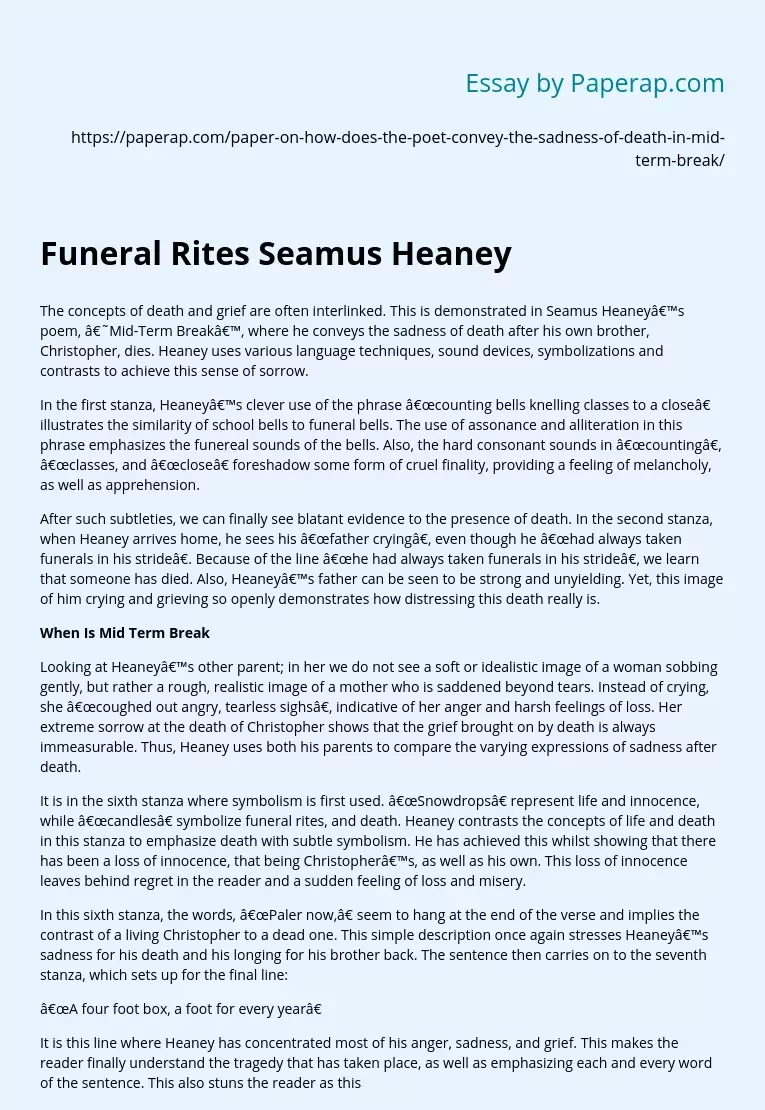The concepts of death and grief are often interlinked. This is demonstrated in Seamus Heaney’s poem, ‘Mid-Term Break’, where he conveys the sadness of death after his own brother, Christopher, dies. Heaney uses various language techniques, sound devices, symbolizations and contrasts to achieve this sense of sorrow.
In the first stanza, Heaney’s clever use of the phrase “counting bells knelling classes to a close” illustrates the similarity of school bells to funeral bells. The use of assonance and alliteration in this phrase emphasizes the funereal sounds of the bells.
Also, the hard consonant sounds in “counting”, “classes, and “close” foreshadow some form of cruel finality, providing a feeling of melancholy, as well as apprehension.
After such subtleties, we can finally see blatant evidence to the presence of death. In the second stanza, when Heaney arrives home, he sees his “father crying”, even though he “had always taken funerals in his stride”. Because of the line “he had always taken funerals in his stride”, we learn that someone has died.
Also, Heaney’s father can be seen to be strong and unyielding. Yet, this image of him crying and grieving so openly demonstrates how distressing this death really is.
When Is Mid Term Break
Looking at Heaney’s other parent; in her we do not see a soft or idealistic image of a woman sobbing gently, but rather a rough, realistic image of a mother who is saddened beyond tears. Instead of crying, she “coughed out angry, tearless sighs”, indicative of her anger and harsh feelings of loss.
Her extreme sorrow at the death of Christopher shows that the grief brought on by death is always immeasurable. Thus, Heaney uses both his parents to compare the varying expressions of sadness after death.
It is in the sixth stanza where symbolism is first used. “Snowdrops” represent life and innocence, while “candles” symbolize funeral rites, and death. Heaney contrasts the concepts of life and death in this stanza to emphasize death with subtle symbolism. He has achieved this whilst showing that there has been a loss of innocence, that being Christopher’s, as well as his own. This loss of innocence leaves behind regret in the reader and a sudden feeling of loss and misery.
In this sixth stanza, the words, “Paler now,” seem to hang at the end of the verse and implies the contrast of a living Christopher to a dead one. This simple description once again stresses Heaney’s sadness for his death and his longing for his brother back. The sentence then carries on to the seventh stanza, which sets up for the final line:
“A four foot box, a foot for every year”
It is this line where Heaney has concentrated most of his anger, sadness, and grief. This makes the reader finally understand the tragedy that has taken place, as well as emphasizing each and every word of the sentence. This also stuns the reader as this is where the reader first realizes how young Heaney’s brother really is, and allows them to fully comprehend the shock and grief the family, and Heaney, must have felt.
However, despite his feelings, throughout the poem, Heaney manages to imply, but not explicitly state, his own feelings. Rather, he sustains an impersonal sense of sorrow and grief, while describing the scenes and atmosphere of that event. This presents the audience with a sense of Heaney’s numbness, a lack of any strong emotions, due to the initial shock of the tragedy.
To emphasize this shock, Heaney has used a very simple free verse with little rhyme and rhythm. This allows the poem to deliver a very simple, yet effective story, and so is definite in its meaning. Phrases such as “Next morning I went into the room” get straight to the point and are not excessively fancy. Heaney’s lack of concern for unnecessary waffle allows him to convey the sadness of death clearly and concisely.
Heaney manages to convey to the reader the feeling of sadness after death. His use of various contrasts of life and death emphasize the death, and the remorse resulting from it. Also, his use of simple, impersonal language and effective sounds allows the reader to fully grasp the severity of this death. In turn, this helps Heaney to implicitly present his own feelings of sadness and sorrow. Also, the final line has been built-up so that the full impact of this event finally hits the reader. His brother is dead and his life fixed in a perpetual “Mid-Term Break”.
Funeral Rites Seamus Heaney. (2019, Dec 05). Retrieved from https://paperap.com/paper-on-how-does-the-poet-convey-the-sadness-of-death-in-mid-term-break/

